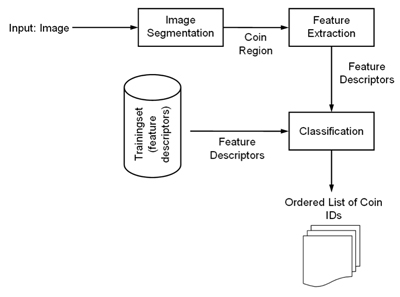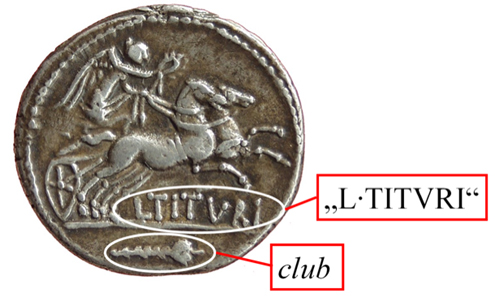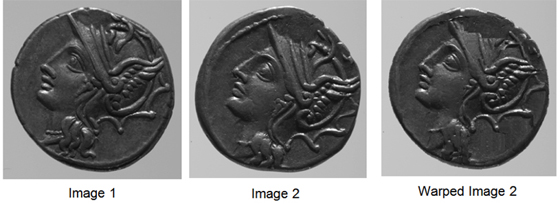by Martin Kampel and Klaus Vondrovec
February 9, 2012 – The Austrian research project ILAC opens the interdisciplinary field of computer vision to numismatic research. One of the applications will be the Computer-aided coin archiving and processing. Martin Kampel and Klaus Vondrovec who are working on ILAC explain what it is all about.
What is it about?
ILAC (Image-based cLassification of Ancient Coins) is an Austrian research project in the interdisciplinary field of computer vision together with numismatics. Numismatics can benefit greatly from the application of computer vision methods and in turn provides a large number of new, challenging and interesting conceptual problems and data for computer vision.
ILAC logo.
In ILAC competences from both fields are brought together: the Computer Vision Lab at the Vienna University of Technology and the Department of Coins and Medals at the Museum of Fine Arts, Vienna. The project’s goal is to build an application for automatic image-based classification of historical coins in large-scale databases.
The broad use of digital cameras has led to an exploding number of digitally recorded coins. While computers are extensively used for storing and working on numismatic data, no image based computer aided classification system for ancient coins has been developed so far. Since specialists are usually able to classify coins from 2D image information only, computer vision methods can be applied to coin images to support numismatists on the examination of coinages as well as to speed up the overall processes significantly. The classification system of ILAC will initially focus on gold and silver issues of the Roman Republican period, but its groundwork is applicable to every other period and can be filled with different sets of coin images, allowing further scientific challenges to be tackled in the future.
What has been done in this area before?
Research on image-based coin analysis is quite new. Initial approaches focused solely on present-day coins. A prominent example in this area is the Dagobert coin recognition system developed at the ARC Seibersdorf research centre for classifying donated coins of European currencies. However, the algorithms for the classification of present-day coins are not directly applicable to ancient coins due to the non-industrial manufacturing of the old coins. As a consequence, specimens within one single class can show a large degree of diversity, whereas the diversity between different classes of coins can be low. The assumption of uniformity and thus a straightforward feature comparison for modern coins facilitates their classification process substantially. This assumption cannot be made for ancient coins. Their classification system therefore has to find general image features to distinguish between coin classes, but at the same time it has to ignore unique features of individual specimens, like border shape and use-wear traces.
Recent research for the image-based recognition of ancient coins was conducted during the EU funded predecessor project COINS, which lasted from February 2007 to January 2009. In COINS eight European partners aimed at developing effective measures to the fight against the illegal trade and theft of ancient coins. Besides the image-based recognition of coins, the project provided standardized inventories by defining a domain ontology, a multilingual thesaurus, data management tools and a specialized web search tool. The recognition of coins focused on the identification of their individual features that permit to classify it among the known features of the database. For this goal an identification method combing shape and die information of the coin was developed. It exploits the discriminative power of the boundary of ancient coins by applying shape matching algorithms as a pre-selection step. Afterwards, the dies of the remaining set are compared to the input image using local image features. The method achieved an identification rate of 98.83 % on a challenging dataset of 2400 coin images.
Challenges of the new project
In contrast to the COINS project, the ILAC project tries to answer a more interesting research question: Given an image showing an unknown coin, the goal is to develop a method that is able to automatically determine the coin type, based on o number different types in a database. This classificatory approach requires essentially different technologies: Identification (COINS) relies on individual, unique features, which make a specimen different from all other individuals in the same class, whereas classification (ILAC) emphasizes general class-specific features to assign an individual coin to a general category.
Figure 1: Coin classification process.
During the project, various techniques and concepts of computer vision are investigated and integrated in the classification system, such as symbol recognition, optical character recognition and content-based image retrieval. In the coin classification process three main stages are passed: coin segmentation, feature extraction and classification (see Figure 1). Local image features will provide a powerful mechanism to detect similarities between coins.
Figure 2: An example for OCR and symbol recognition on a Roman Republican Coin (MK RÖ 3965).
Furthermore, the coin inscription obtained by using optical character recognition methods and the recognition of certain symbols can restrict the set of possible classes to a great extent (see Figure 2).
What could be the implications of the project for the future?
If this project is successful, its groundwork is applicable to every other period and can be filled with different sets of coin images. When the amount of reference-data is increased or wider monetary fields are initiated, numismatists will have to supply more material and tackle further scientific challenges. The basic research conducted in this project will possibly have implications for currently unthought-of applications, like dealing with huge coin-hoards or monitoring internet-trade.
What is the current status?
The ILAC project started in January 2011 and will last until December 2013. In the first year, the Roman Republican coin collection of the Museum of Fine Arts Vienna has been photographed to provide a comprehensive basis for the algorithms to be developed. First results on coin classification have been presented at the International Symposium on Virtual Reality, Archaeology and Cultural Heritage (VAST 2011) in Prato, Italy, and the 16th International Conference on Cultural Heritage and New Technologies (CHNT 2011) in Vienna.
Figure 3: Comparison of coin images.
The presented prototype is able to measure the similarity of coin images by automatically determining the most reasonable alignment of coins (see Figure 3). Classification by using this similarity measure achieves an accuracy of 74 % on a small subset of 24 types of the Roman Republican period from 131-102 B.C. An improved classification system and first results on automatic legend recognition will be presented at the Computer Applications and Quantitative Methods in Archaeology Conference in March 2012 in Southampton, UK. At this conference, the ILAC project team is organizing a special session on Computer-aided coin archiving and processing with contributions from 10 international researchers.
Contacts:
PD Dr. Martin Kampel, Vienna University of Technology, email.
Dr. Klaus Vondrovec, Museum of Fine Arts Vienna, email.
You may want to visit the ILAC website to learn more about the project, to do so please click here.
The Computer Vision Lab is presented here.
Visit the interesting Department of Coins and Medals at the Museum of Fine Arts, Vienna!
A youtube explains the Dagobert coin recognition system.
Learn more about the EU funded predecessor project COINS.
This is the website of the International Symposium on Virtual Reality, Archaeology and Cultural Heritage (VAST 2011) in Prato, Italy …
… and this of the 16th International Conference on Cultural Heritage and New Technologies (CHNT 2011) in Vienna.
There will be a Computer Applications and Quantitative Methods in Archaeology Conference in March 2012 in Southampton, UK. All information on this event you will find here.
And to inform yourself on the special session on Computer-aided coin archiving and processing during the Southampton conference, please follow this link.








